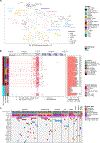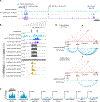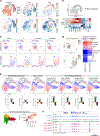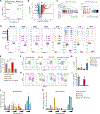Enhancer Hijacking Drives Oncogenic BCL11B Expression in Lineage-Ambiguous Stem Cell Leukemia
- PMID: 34103329
- PMCID: PMC8563395
- DOI: 10.1158/2159-8290.CD-21-0145
Enhancer Hijacking Drives Oncogenic BCL11B Expression in Lineage-Ambiguous Stem Cell Leukemia
Abstract
Lineage-ambiguous leukemias are high-risk malignancies of poorly understood genetic basis. Here, we describe a distinct subgroup of acute leukemia with expression of myeloid, T lymphoid, and stem cell markers driven by aberrant allele-specific deregulation of BCL11B, a master transcription factor responsible for thymic T-lineage commitment and specification. Mechanistically, this deregulation was driven by chromosomal rearrangements that juxtapose BCL11B to superenhancers active in hematopoietic progenitors, or focal amplifications that generate a superenhancer from a noncoding element distal to BCL11B. Chromatin conformation analyses demonstrated long-range interactions of rearranged enhancers with the expressed BCL11B allele and association of BCL11B with activated hematopoietic progenitor cell cis-regulatory elements, suggesting BCL11B is aberrantly co-opted into a gene regulatory network that drives transformation by maintaining a progenitor state. These data support a role for ectopic BCL11B expression in primitive hematopoietic cells mediated by enhancer hijacking as an oncogenic driver of human lineage-ambiguous leukemia. SIGNIFICANCE: Lineage-ambiguous leukemias pose significant diagnostic and therapeutic challenges due to a poorly understood molecular and cellular basis. We identify oncogenic deregulation of BCL11B driven by diverse structural alterations, including de novo superenhancer generation, as the driving feature of a subset of lineage-ambiguous leukemias that transcend current diagnostic boundaries.This article is highlighted in the In This Issue feature, p. 2659.
©2021 American Association for Cancer Research.
Figures






References
-
- Khan M, Siddiqi R, Naqvi K. An update on classification, genetics, and clinical approach to mixed phenotype acute leukemia (MPAL). Ann Hematol 2018;97(6):945–53. - PubMed
-
- Charles NJ, Boyer DF. Mixed-Phenotype Acute Leukemia: Diagnostic Criteria and Pitfalls. Archives of pathology & laboratory medicine 2017;141(11):1462–8. - PubMed
Publication types
MeSH terms
Substances
Grants and funding
- R35 CA210065/CA/NCI NIH HHS/United States
- UG1 CA233290/CA/NCI NIH HHS/United States
- T32 CA236748/CA/NCI NIH HHS/United States
- UG1 CA232760/CA/NCI NIH HHS/United States
- P30 CA021765/CA/NCI NIH HHS/United States
- U10 CA180794/CA/NCI NIH HHS/United States
- P50 GM115279/GM/NIGMS NIH HHS/United States
- UG1 CA233234/CA/NCI NIH HHS/United States
- R35 CA197695/CA/NCI NIH HHS/United States
- UG1 CA189859/CA/NCI NIH HHS/United States
- R01 CA216391/CA/NCI NIH HHS/United States
- RN380110-409786/CIHR/Canada
- U24 CA196172/CA/NCI NIH HHS/United States
- K99 CA279756/CA/NCI NIH HHS/United States
- U10 CA180821/CA/NCI NIH HHS/United States
- U24 CA196171/CA/NCI NIH HHS/United States
- F32 CA254140/CA/NCI NIH HHS/United States
- RC1 CA145707/CA/NCI NIH HHS/United States
- U10 CA180820/CA/NCI NIH HHS/United States
- R00 CA241297/CA/NCI NIH HHS/United States
LinkOut - more resources
Full Text Sources
Other Literature Sources
Medical
Molecular Biology Databases

